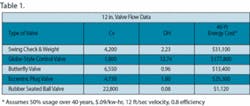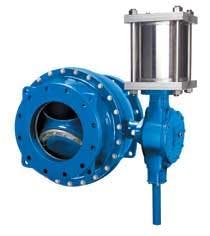Advantages Clear on Rubber Seat Ball Valve
In these times of conservation and “green” design, the Val-Matic Ener•G™ AWWA ball rubber seated ball valve offers distinct advantages for tight seating, long life and energy savings. When fully open, the valve provides 100% clear flow area equal to the valve size. Hence, the valve head loss is equal to an equivalent length of pipe. This represents a significant savings in pumping costs.
An important characteristic of valves in water pumping systems often overlooked is the valve's ability to minimize energy consumption. Common flow coefficients for various valves used in pumping systems are shown in Table 1. Since Cv represents the flow through a valve with a 1 psi pressure drop, we can see that a ball valve has the best head loss characteristics.
The table also shows that the Val-Matic ball valve, with its low energy cost, pays for itself over its life. It consumes less than 1% the energy of a globe-style control valve. Larger systems and systems operating at higher velocities will provide even greater savings.
And the valve fully complies with the ANSI/AWWA C507 standard for design and testing. Advantages include a standard fusion-bonded epoxy interior and exterior coating and a bi-directional resilient Tri-Loc™ seating system. This seat retention system provides a low-friction, wear-resistant seat and allows easy adjustment or replacement of the seat without removing the valve from the line.
The Ener•G ball valve is available with manual, cylinder or motor actuation. All actuators are built in accordance with AWWA Standard C507 for Ball Valves, with power actuators built according to C540. Manual and cylinder actuators are designed and built by Val-Matic with the exclusive feature of externally adjustable stops for easy adjustment.
The traveling nut manual actuator was specifically designed and built to match the torque characteristics of this valve and is rated to 450 ft-lbs of input torque. It provides characterized closure to allow the valve to slowly close during the last half of travel to reduce pipeline surges.
Cylinder actuators include cylinder heads and barrels constructed of stainless steel or non-metallic materials. Seals in the cylinder are suitable for air, oil or water supply and can be replaced without removing the cylinder from the actuator unit. Motor actuators are available to suit multiple speeds and voltages with features to protect the actuator and ball valve. A hand wheel gear set with declutch is included for manual positioning of the valve.
Ideal for surge control in energy efficient pumping systems, the Ener•G ball valve is available in 150 lb. and 300 lb. AWWA classes in sizes 6"-48".
With over 50 years of combined ball valve knowledge in the areas of engineering, manufacturing, application and design, Val-Matic Valve & Manufacturing Corp. is based in Elmhurst, IL. It's the first U.S. valve manufacturer to be certified to the new ISO 9001:2008 certification after an audit from Lloyd's Register Quality Assurance. Contact: 630-941-7600, [email protected] or www.valmatic.com

